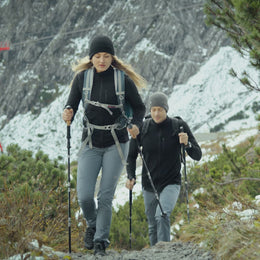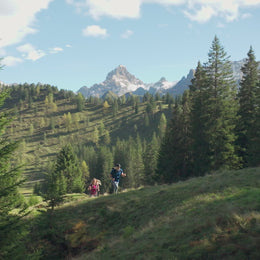30 Jan 2022
Alles, was du über Wanderstöcke wissen solltest.
Eine Anleitung für Dummies

Ratschläge über Wanderstöcke aus der Praxis:
Folgende Fragen zu Wanderstöcken/Faltstöcken werden in diesem Blog Beitrag geklärt:
- Warum Wanderstöcke?
- Wann sind Trekkingstöcke
überhaupt sinnvoll? - Wie lang sollten Wanderstöcke sein?
- Welche Wanderstöcke bei welcher
Körpergröße?
- Wie lang müssen Nordic Walking Stöcke
sein? - Wie geht man richtig mit Wanderstöcken?
- Die häufigsten Fehler
- Gehtechnik: Wie wird es richtig gemacht - Faltstöcke am Rucksack anbringen
- Befestigungstipps für Trekkingstöcke - Wie transportiere ich Wanderstöcke im
Flugzeug? - Fazit: Was sind gute Wanderstöcke?
Neuerdings kommen dir alle Stock-Schwingungen entgegen oder Du schwingst selber schon , du weißt aber nicht so recht warum? Dann empfehle ich dir an dieser Stelle weiterzulesen. Dieser Blog-Beitrag deckt die häufigsten Fragen über Wanderstöcke ab und wird dir eine Hilfestellung für die Praxis sein.
1. Warum Wanderstöcke?
Du hast dich sicherlich schon oft gefragt “Wann sind Trekkingstöcke überhaupt sinnvoll?” Weshalb jemand Wanderstöcke benutzt, kann sehr unterschiedliche Gründe haben. Prinzipiell haben Wanderstöcke viele positive Eigenschaften:
Unterstützung der Gelenke
Wanderstöcke wirken entlastend für Füße, Beine, Knie und Rücken. Besonders beim Abwärts gehen werden die Knie sehr stark belastet. Du sparst Energie, deine Konzentration lässt nicht so schnell nach, und du bist sicherer beim Bergab steigen.

Besonders beim Abwärtsgehen werden die Gelenke sehr stark belastet.
Gleichgewicht
Die meisten Unfälle beim Wandern passieren durch Rutschen oder Stolpern. Wenn du zusätzlich müde bist, deine Konzentration nachlässt, ist die Gefahr eines Sturzes nochmal wesentlich größer. Die Wanderstöcke sind wie Verlängerungen deiner Arme, die dich stützen und dir einen besseren Halt geben. Du hast dadurch zusätzliche Stabilität.
Körperhaltung und Atmung
Durch das Benutzen von Wanderstöcken kannst du deine Körperhaltung verbessern. Wenn du einen schweren Rucksack auf dem Rücken trägst, unterstützen die Stöcke deine aufrechte Haltung. Wanderstöcke provozieren den Gang in aufrechter Haltung. Es ist fast unmöglich, mit Wanderstöcke nicht aufrecht zu gehen. Deine Schultern können vorne nicht ‘zusammen klappen’. Zusätzlich wird durch die aufrechte Haltung die Atmung gefördert. Du bekommst leichter Luft. Eine bewusste Atmung ist bei Ausdauersport essentiell, damit du dich länger konzentrieren kannst, du nicht so schnell ermüdest und somit unfallfrei bleibst.

Es macht einen Unterschied, ob du dich aufwärts
oder abwärts bewegst. Die Wanderstöcke sollten
dem Terrain und deiner Körpergröße entsprechend angepasst werden.

Sicherheit
Wie du aus den vorigen Punkten herauslesen kannst, helfen dir die Wanderstöcke in vielerlei Hinsicht. Du bleibst länger Unfallfrei in dem du deine Gelenke unterstützt, dein Gleichgewicht förderst, deine Haltung nicht zusätzlich strapazierst, sondern eine gesunde Körperhaltung förderst. Generell wirkt diese Gehhilfe positiv auf Deinen Energiehaushalt, somit kannst du das Wandern oder Laufen richtig genießen.
Nordic Walking
Die schwungvolle Bewegung beim Nordic Walking beansprucht Herz und Kreislauf, regt den Stoffwechsel an, stärkt Muskeln und Knochen und rückt überschüssigen Pfunden zu Leibe. Wer die Stöcke fleißig vor und zurück schwingt, kräftigt zudem Arme, Schultern und Rücken.
2. Wie lang sollten Wanderstöcke sein?
Die Wanderstöcke sollten dem Gelände angepasst werden. Beim Abstieg sollten die Stöcke etwas länger und beim Aufstieg etwas kürzer eingestellt werden. In der Regel aber sollte der Stock so lang eingestellt werden, dass die Hand den Griff leicht greifen kann, während der Arm im rechten Winkel zum Boden steht. Der Unterarm ist parallel zum Boden und am Ellbogen gebeugt.
Welche Wanderstöcke bei welcher Körpergröße?
Viele Unternehmen bieten Richtlinien für die richtige Länge für die Körpergröße an. Es kann jedoch sehr individuell sein, wie ein Stock eingestellt wird. Wichtig ist, wie oben beschrieben, das die Grundeinstellung in einem rechten Winkel erfolgt.

Ober- und Unterarm sollten in einem rechten Winkel zum Grund erfolgen.
Wie lang sollten Nordic Walking Stöcke sein?
Da diese Frage oft speziell auch für Nordic Walking Stöcke auftaucht, behandeln wir diese Frage hier gesondert. Der Abstand zwischen Stock und Körper sollte circa eine halbe Armlänge betragen. Wenn dein Arm in einem 90 Grad Winkel gebeugt ist, sollten die Stöcke an deinen Unterarmen enden. Das 90 Grad Prinzip ist also genau gleich wie bei herkömmlichen “Trekkingstöcken” Zusätzlich gibt es die Methode für die Berechnung der Länge. Dafür multiplizierst du deine Körpergröße in Zentimeter mit 0,7. Das Ergebnis ist die Stocklänge.
3. Wie geht man richtig mit Wanderstöcken?
Die häufigsten Fehler:
- Die Trekkingstöcke sind zu lang
eingestellt.
- Der Stockeinsatz ist zu unpräzise.
- Die Stöcke werden zu weit neben dem
Körper geführt.
- Die Ellenbogen sind zu stark angewinkelt.
- Die Stöcke werden kaum belastet.
- Die Stockschleifen werden falsch verwendet.
Gehtechnik: Wie wird es richtig gemacht
Die Größe
Zu aller erst stellst du deine Wanderstöcke auf die richtige Größe ein. Siehe Punkt Nummer 2.
Der Griff
Ein häufiger Fehler ist der falsche Griff, bei dem die Schlaufe oft einfach von oben eingefädelt wird. Richtigerweise solltest du von unten durch die Schlaufe greifen, so dass man selbst mit geöffneter bzw. lockerer Hand Druck auf den Stock ausüben kann. Dadurch kann man die Hände bei der Ausholbewegung öffnen, ohne auf die Entlastung zu verzichten. Tipp: Damit die Hände nicht verkrampfen, solltest du bei der Ausholbewegung darauf achten, den Griff locker zu lassen.
Wichtig: Die Schlaufe sollte nur im relativen flachen Gelände benutzt werden. Wer stürzt und eingefädelt ist, kann nicht nach dem Griff greifen oder sich abstützen. Die Verletzungsgefahr ist dadurch um einiges höher.
Haltung
Um den bestmöglichen Effekt zu erzielen ist es ratsam, die Stöcke immer nah am Körper zu führen. In flachem Gelände sind die Stöcke diagonal zu den Beinen und werden abwechselnd eingesetzt, entsprechend dem natürlichen Bewegungsmuster.
Steiles Gelände
In steilem Gelände ist der Doppelstockeinsatz die Variante, die du anwenden solltest. Die Stöcke werden in der Regel bei jedem zweiten Schritt gesetzt und Du drückst Dich kraftvoll mit beiden Armen nach oben. So sind Stabilität und Entlastung gewährleistet.
Bergab
Auch bergab ist die Doppelstocktechnik die beste Wahl. Du solltest dich nicht ins Gelände bohren, sondern den Griff so greifen bzw. halten, dass Du eine saubere Technik ausführen kannst. So rutscht Du nicht weg und vermeidest Stürze.
Querungen
Bei Querungen müssen Stöcke nicht zwingend anders eingestellt werden. Es reicht, wenn Du den bergseitigen Stock unterhalb des Griffes festhält und talseits den Griff wie ein Knauf von oben umfasst.
Sehr steiles Gelände und Traversen
Sehr steiles Gelände und Traversen solltest du uneingeschlauft passieren. Der Stock sollte hier ‘nur’ als Stütze verwendet werden. Es gibt auch die Möglichkeit, einen Stock mit beiden Händen zu umfassen. "Das ist eine alte Methode, wie es die Bergsteiger damals gemacht haben. So Wolfgang Loacker, erfahrener Berg- und Skiführer im Montafon." Steiles Gelände solltest Du aber prinzipiell nur begehen, wenn Du fit genug bist und Erfahrung hast, bzw. eine*n Expertin/Experten dabei hast.

Die Stöcke sollten immer nah am Körper geführt werden.
4. Faltstöcke am Rucksack anbringen
Befestigungstipps für Trekkingstöcke
Die Stöcke im Rucksack
Mittlerweile bieten unzählige Rucksack Firmen unterschiedlichste Anbringungsmöglichkeiten von Wanderstöcken an. Dies bedeutet aber nicht automatisch, dass außen angebrachte Wanderstöcke der Idealfall sind. Im besten Fall solltest Du deinen Rucksack so planen, dass Du außen keine Ausrüstung anbringen musst. Outdoor Equipment, dass außen befestigt ist, kann erhebliche Nachteile mit sich bringen. "Es ist sicherer Trekkingstöcke im Rucksack aufzubewahren. Zum einen können sie leicht verloren gehen und wenn man stürzt ist die Verletzungsgefahr höher", so Wolfang Loacker - österreichischer Berg- und Skiführer. Zusätzlich ist die Gewichtsverteilung, bei außen angebrachten Wanderstöcken, nur suboptimal. Gewicht zieht nach hinten und nach unten. Zum einen wird das Wandern anstrengender, und bei kniffligen Passagen kannst Du ins Schwanken kommen.
Die Spitze am Rucksack
Die Befestigungsmöglichkeit hängt sehr stark von deinem Rucksack ab. Trekking- und Wanderrucksäcke haben in den meisten Fällen Schlaufen und Hacken die es ermöglichen die Stöcke einzustecken und einzufädeln. Bei Schlaufen wird (die Spitze) unten hineingesteckt. Bei Stöcken ohne Teller findet die kleine Schlaufe Verwendung, bei Stöcken mit Tellern die große Schlaufe. Die Teller verhindern üblicherweise ein Durchrutschen. Ansonsten kannst Du Stockteller auch mit wenigen Handgriffen herunter drehen.

Hier werden die Stöcke am Rucksack eingefädelt und festgezogen.
Wichtig: Weite Schlaufen sind nicht unbedingt dafür gedacht Wanderstöcke anzubringen. Vor allem an Ski- und Kletterrucksäcken sind weite Schlaufen dafür gedacht, Eisgeräte und Seile festzumachen.
Kompressionsriemen
Kompressionsriemen sind Schlaufen, meist rechts oder links am Rucksack angebracht, die zugezogen werden können. Die Wanderstöcke werden sozusagen umschlossen und festgezogen. So schlenkern deine Stöcke nicht hin- und her und sitzen fest und sicher an deinem Rucksack.
Klett- und Kabelbinder
Eine Alternative sind externe Klettverschlüsse sowie Kabelbinder um Wanderstöcke am Rucksack zu fixieren. Diese Methoden setzen voraus, dass Du am Rucksack schon ein vorhandenes System hast, an denen Du deine externen Klett- oder Kabelbinder einfädeln kannst. Vor allem die Klettverschluss Methode ist nur für den Transport geeignet.
Beispiele für die praktische Anwendung von Kabelbinder an Rucksäcken:
Mit öffentlichen Verkehrsmitteln wie Busse oder Zügen. Wenn Dein Rucksack bspw. auf einem Autodach verstaut wird, hast Du keine direkte Einsicht und kannst im Notfall nicht nachjustieren. Mit fest zugezogenen Kabelbindern halten Deine Trekkingstöcke bombenfest am Rucksack. Gerade auf Backpacking Touren ist man oft mit verschieden Transportmitteln unterwegs. Es kann sinnvoll sein, die Stöcke zusätzlich mit Kabelbindern zu fixieren.
5. Wie transportiere ich Wanderstöcke im Flugzeug?
Wander-oder Trekkingstöcke sind im Handgepäck nicht erlaubt. Das gilt auch für Teleskop-Stöcke, die sich zusammenschieben lassen. Grund hierfür ist, dass Wander- oder Trekkingstöcke an der Sicherheitskontrolle zu den gefährlichen Gegenständen gezählt werden, weil sie sich potentiell auch als Waffen verwenden lassen. Wanderstöcke können nur im Aufgabegepäck mitgenommen werden. Klappbare- oder Teleskop-Wanderstöcke sind hier von Vorteil. Diese können einfach er im Koffer oder Rucksack verstaut werden. Es muss keine zusätzliche Gebühr bezahlt werden und der Koffer kann platzsparend gepackt werden. Bei nicht faltbaren Stöcken muss eine zusätzliche Gebühr gezahlt werden, da es sich um Sperrgepäck handelt und diese Art von Stöcken nicht in den Koffer passt.Die einzige Ausnahme beim Handgepäck bilden Gehhilfen wie Krücken oder Gehstöcke, wenn diese aus einem medizinischen Grund notwendig sind.
6. Fazit: Was sind gute Wanderstöcke?
Die eigenen Bedürfnisse stehen an erster Stelle. Dies ist der erste Anhaltspunkt wie du deine Stöcke auswählen solltest, damit es ein “guter” Stock für dich wird. Körpergröße und Körpergewicht helfen dir in diesem Punkt weiter. Bei guten Wanderstöcken sollte an zweiter Stelle immer das Preis-Leistungsverhältnis passen. Vergleichen und Erfahrungsberichte helfen hier weiter. Wenn du dir nicht sicher bist, für welche Gelegenheiten du die Stöcke überhaupt verwendest, ist es ratsam nicht zu spezifisch einzukaufen. Sondern ein paar Stöcke, das für mehrere Einsatzbereiche verwendet werden kann zu erwerben. Ansonsten gilt es, Stöcke nach dem Einsatzzweck auszuwählen. Wenn du die Stöcke hauptsächlich für entspannte Wanderungen im Flachland brauchst, dürften Aluminium-Teleskopstöcke völlig reichen. Möchtest du allerdings auch Mehrtagestouren oder ins Gebirge, dann sind faltbare Aluminium- oder Carbonstöcke zu empfehlen. Es gibt keine eindeutige Antwort was einen guten Wanderstock ausmacht und was nicht. Bei falschem Einsatz und falscher Handhabung, nützt dir der teuerste und leichteste Carbonstock nichts mehr. Viel wichtiger ist es, sich mit dem Material auseinanderzusetzen und die eigenen Bedürfnisse zu kennen um einen passenden Stock auszuwählen.

Was sind Deine Bedürfnisse? Dies ist einer der wichtigsten Anhaltspunkte wie du deine
Wanderstöcke/Faltstöcke auswählen solltest.
Ende




















